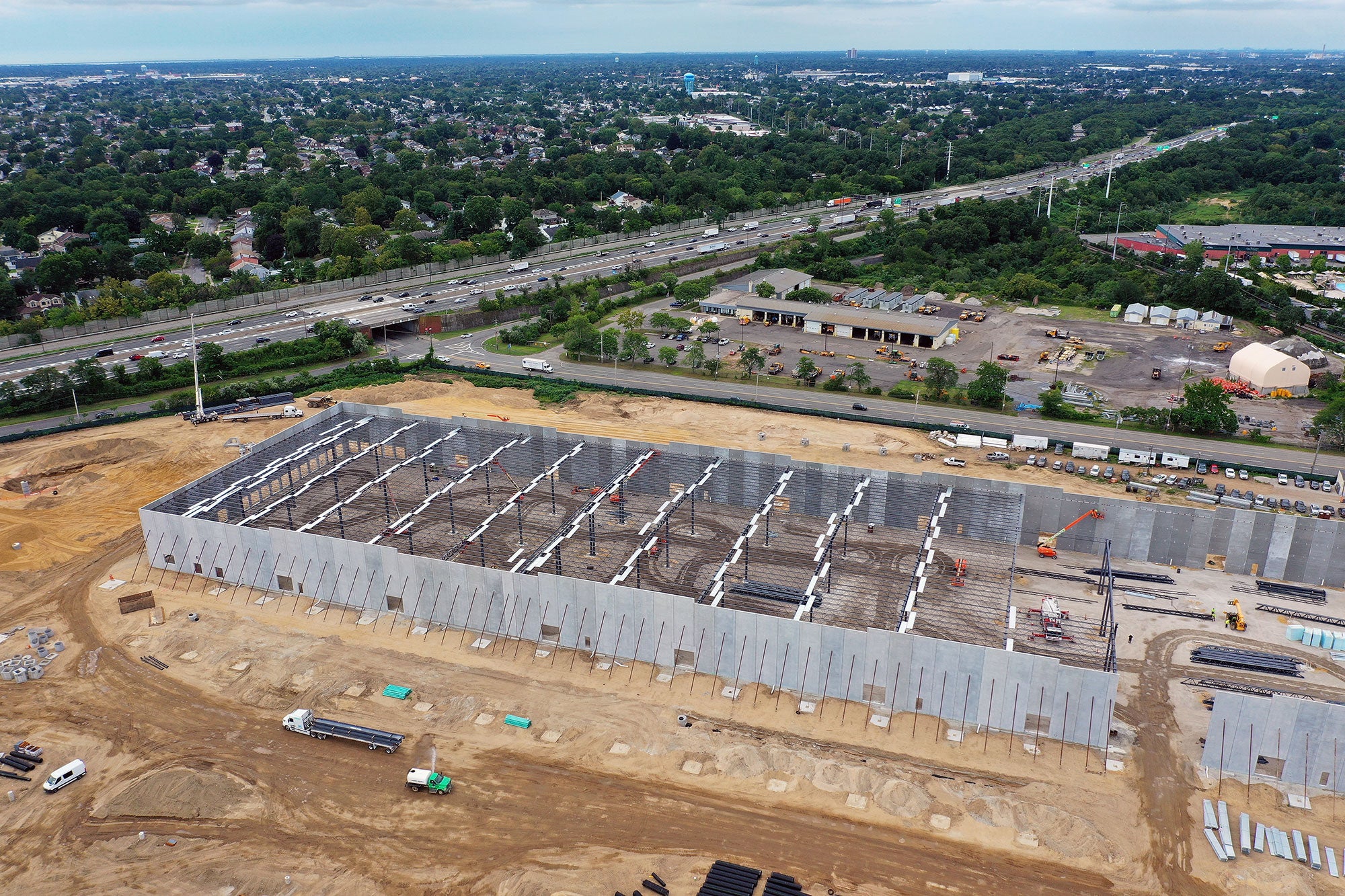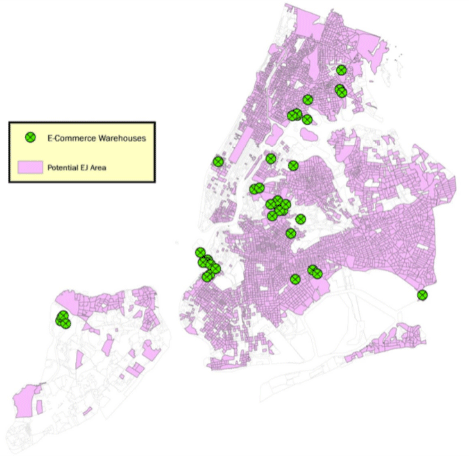March 30, 2023
Strengthening Zoning Regulations on Last-Mile Warehouses
Amending regulations on last-mile warehouses is critical to achieving New York City’s environmental justice and racial equity goals

The e-commerce sector has experienced exponential growth in the last decade, with consumer demand for online goods surging by over 33% between 2019 and 2020 alone.
The influx of demand coupled with online retailers’ same- or next-day delivery guarantees has accelerated the buildout of logistical “last-mile” warehouses sited disproportionately within or surrounding lower income communities and communities of color in New York State.
In New York City, last-mile warehouses can currently be built directly adjacent to certain residential neighborhoods, predominantly communities of color and lower-income communities, without any review or mitigation of traffic, public safety, or air quality impacts. The lack of these protections in the City’s Zoning Resolution directly undermines the City’s racial equity and environmental justice goals.


About the Last-Mile Coalition
The Last-Mile Coalition is a city-wide coalition of environmental justice and public health advocates, made up of Earthjustice, The New York City Environmental Justice Alliance, The Point CDC, UPROSE, El Puente, Red Hook Initiative, and New York Lawyers for the Public Interest.
Increased diesel emissions from the uptick in warehouse delivery truck traffic has serious public health impacts, particularly among communities of color and lower-income communities, who already breathe dirtier air than white and affluent New Yorkers.
The Last-Mile Coalition has started the process to amend New York City’s Zoning Resolution to prevent last-mile warehouse facilities from clustering too close to one another in a particular neighborhood, provide communities and City agencies an opportunity to plan for a new facility’s public health and environmental impacts, and give the City authority to require mitigation of negative impacts.
The “last-mile” in e-commerce refers to the final stage of the delivery fulfillment process, where the item is transferred from the retailer’s warehouse to the customer’s doorstep.
Concentrations of last-mile warehouses have an outsized impact on air quality, greenhouse gas emissions, and noise pollution compared to a traditional warehouse due to a range of factors, including higher numbers of truck trips because of higher volumes of product flow, larger square footage needed to house inventory, and 24/7 operating times.
Because last-mile warehouses are not explicitly defined under New York City zoning law, the NYC Department of City Planning (DCP) treats them as “warehouses” that can be constructed “as-of-right” in manufacturing districts and C8 commercial districts. This means that as long as the project meets the City’s zoning ordinance requirements, no additional public input process or environmental review is required for the developer to be issued a permit and begin construction.
Because freight transport is primarily carried out over waterways and by truck, e-commerce companies look to site their last-mile warehouses in areas close to waterfronts and highways. These areas are more likely to be in low-income neighborhoods that are predominantly Black and Hispanic / Latinx, thus subjecting these communities to greater environmental and public health burdens.
Health outcomes reflect this disparity: Black and Hispanic / Latinx New Yorkers are 7 and 4 times more likely, respectively, to visit the emergency department for asthma than white New Yorkers, and 3–4 times more likely to die from asthma. Ozone-attributable asthma hospitalization rates are 4 times higher in high-poverty neighborhoods compared to low-poverty neighborhoods.
Last-mile warehouses worsen rates of air pollution, noise pollution, and traffic congestion in the neighborhoods they move into. Medium- and heavy-duty trucks, which make up less than 5% of vehicles on the road yet contribute 20% of the nation’s transit sector emissions, are continuously driving through residential corridors, loading and unloading inventory for delivery to peoples’ homes. In the U.S., 76% of commercial delivery trucks run on diesel engines, which emit higher levels of particulate matter (PM2.5) and nitrous oxide (NOx) pollution than gasoline engines. While U.S. commercial adoption of zero-emission trucks is increasing, they currently only make up .005% of all medium and heavy-duty trucks on the road. Diesel trucks will continue to make up the majority of delivery trucks on the road for at least the next decade.
Particulate matter (PM2.5) is a deadly pollutant that can enter deep into the lungs, aggravating asthma and increasing one’s risk of lung cancer, miscarriages, heart attacks, and premature death, according to the World Health Organization. Chronic exposure to NOx emissions significantly reduces lung function, worsens breathing problems like bronchitis and emphysema, and is linked to headaches and eye irritation.
An estimated 16.3 million square feet of e-commerce warehouses have been planned or developed in New York City, predominantly clustered within Brooklyn, The Bronx, Staten Island, and Queens.
At least eight facilities are being developed in Brooklyn’s majority Black and Latinx neighborhoods of Sunset Park and Red Hook, where nearly 100% of children under 5 years old live within 0.5 miles of a warehouse. These neighborhoods already have higher levels of fine particulate matter than the City average: air monitoring data shows that Red Hook’s average PM2.5 concentration is almost triple the New York City average and above the World Health Organization’s threshold for acceptable PM2.5 levels. Sunset Park’s average PM2.5 level is better, but still above the norm.
These facilities are alarmingly concentrated within communities of color, particularly Bronx Community Districts 1 and 2, and Brooklyn Community Districts 5, 6, and 7.
Bronx Community Districts 1 and 2 (composed of the neighborhoods Mott Haven, Melrose, Hunts Point, and Longwood) are 68.3% Hispanic, 27.7.% Black, 2.6% White, and 0.5% Asian.
- Hunts Point and Longwood have the highest asthma rates in New York City with 9.7% of adults diagnosed with asthma. Data from New York City’s Neighborhood Health Atlas found that the average number of preventable asthma hospitalizations in this district is three times that of the New York City average.
Brooklyn Community District 5, containing East New York and Starrett City, is 55.4% Black, 34.9% Hispanic, 4% Asian and 4.2% White.
Brooklyn Community District 6 is made up of neighborhoods Park Slope, Carroll Gardens, and Red Hook.
- Park Slope and Carroll Gardens are 67.8% White, 8.5% Black, 10.5% Hispanic, and 8.5% Asian.
- Red Hook, by contrast, is 18% White, 41% Black, 33% Hispanic, and 5% Asian.
- Residents are far more likely to be white and wealthy in Carroll Gardens and Park Slope than in Red Hook.
- However, the many last-mile warehouse facilities under construction in Community District 6 are clustered in a section of Red Hook surrounding the Red Hook Houses, the largest public housing development in Brooklyn, where the demographics differ significantly from those of the rest of the community district.
Brooklyn Community District 7 is made up of the neighborhoods Sunset Park and Windsor Terrace. The district is 3.4% Black, 35.6% Hispanic, 34.8% Asian, and 23.7% White.
While e-commerce companies tout their logistics and distribution centers as vital job creators, these jobs often fail to provide adequate benefits or fulltime employment, and have starkly higher injury and turnover rates than the manufacturing and industrial sectors.
2020 data from the Bureau of Labor Statistics found that the transportation and warehousing sector had more worker fatalities than the manufacturing, retail trade, and educational and health services sectors combined. In 2021 the transportation and warehousing sector had a 49% turnover rate, significantly higher than the durable goods manufacturing sector’s 35.3%.
Amazon, which opens a warehouse at a rate of one per day and is planning to open three in Sunset Park and Red Hook, reported over 34,000 serious injuries at its warehouse facilities in 2021, more than twice the injury rate of non-Amazon warehouses.
While Amazon’s net income in 2021 climbed to $33 billion, a 56% increase from 2020, a study by the U.S. Government Accountability Office found that many of its warehouse employees are struggling to make ends meet: over 4,000 Amazon warehouse employees are on food stamps in nine states.
The majority of available last-mile data focuses on Amazon, but it is by no means the only e-commerce company expanding warehouse operations in New York City: shipping giants FedEx and UPS have also been spending billions purchasing property to house new facilities.
Last-mile warehouses threaten to use up a high portion of land set aside for manufacturing and thus crowd out local manufacturing businesses, which typically have higher-paying jobs than logistics warehouses. Manufacturing and industrial jobs have traditionally provided stable, well-paying employment that has allowed New Yorkers, particularly New Yorkers of color without college degrees, to reach the middle class.
The proposed city-wide text amendment would change the Zoning Resolution to advance the City’s environmental and climate justice commitments. The amendment would allow last-mile warehouses to continue to be built in manufacturing and C8 districts, but would provide opportunities for community input and environmental and other mitigation measures as well as planning for traffic impacts, thus balancing the need for these facilities in the chain of commerce and the benefit of jobs they bring with communities’ need for clean air and safe streets. In this way, the amendment would encourage equitable development and thriving communities.
To ensure that the negative environmental, public health, and safety impacts of last-mile warehouse operations do not disproportionately fall on a small number of communities, the amendment would require that facilities meet certain conditions prior to obtaining a special permit to operate in dense, urban environments:
- Facilities must be set back from schools, parks, and public housing as well as from one another;
- Developers must demonstrate that the facilities will not create undue air pollution or traffic congestion impacts in the surrounding area;
- The New York City Planning Commission can require additional mitigation measures based on a facility’s potential impact. These measures include prioritizing the use of waterways, railways, bikes, or electric vehicles to deliver goods.
E-commerce companies already have the technological and financial resources to deliver on their net-zero commitments by taking these feasible, yet critical, steps.
Media Inquiries: Bala Sivaraman, Earthjustice, bsivaraman@earthjustice.org
Established in 2008, Earthjustice’s Northeast Office, located in New York City, is at the forefront of issues at the intersection of energy, environmental health, and social justice.